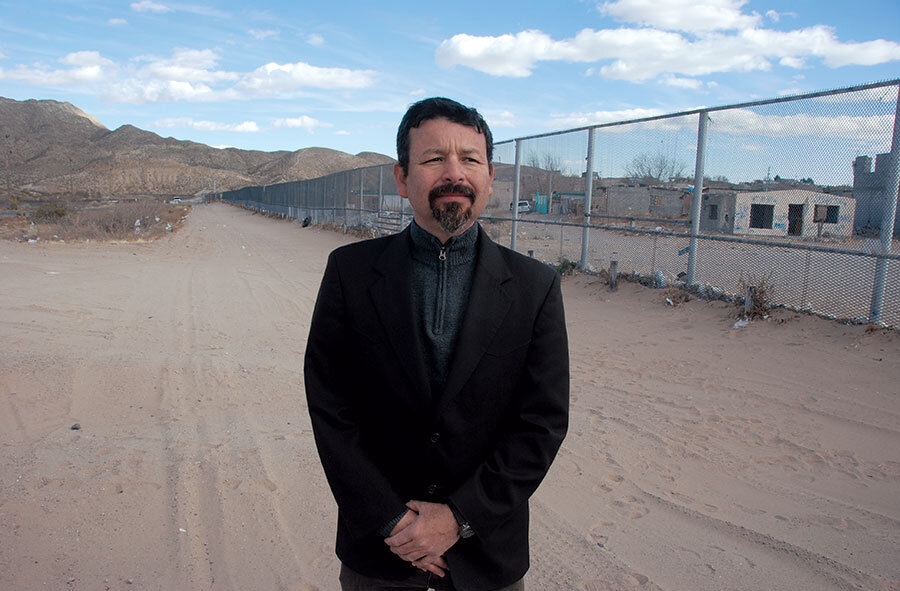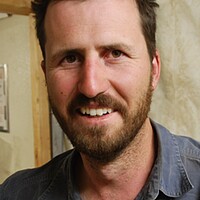Fernando Garcia bridges the gap between residents and law enforcers in El Paso, Texas
Loading...
| El Paso, Texas
Like others mired in the day-to-day slog of their work, Fernando Garcia had lost sight of the leaps forward he'd made in more than 15 years working on immigrant rights.
Mr. Garcia is the director of the Border Network for Human Rights (BNHR), an organization based in El Paso, Texas, that documents the abuse and mistreatment of immigrants by US authorities and advocates for reform.
When his group crunched the numbers for 2013, Garcia didn't believe the results at first. After rechecking the figures and sending volunteers back into communities to make sure they hadn't missed anything, the report confirmed that neither the US border patrol nor the El Paso County Sheriff's Office had registered any incidents last year.
Although other organizations the BNHR monitors had registered incidents, the records of the border patrol and sheriff's office represented a major stride forward.
The improvements have led Garcia and his organization to look at the lessons learned and work toward creating a model that can be applied in other border towns to improve relations between the local community and law enforcement officials.
"Border Network implemented an important strategy of not only denouncing, but also proposing solutions to some of the problems," Garcia says. "We want to expand to make it a national model."
Bridging the gap between the community and law enforcement agencies is at the heart of the El Paso model. Through documenting abuses, Garcia and BNHR have opened up communication channels between the community and US Customs and Border Protection (CBP) and other law enforcement agencies. All parties are in regular contact. Incidents may persist, but both sides now have someone to speak to when an incident arises.
Garcia grew up in Mexico City, but his grandparents moved to southern California in the 1960s, and he crossed the border to visit them often.
After studying journalism in college, he took a job with a magazine in Ciudad Juárez, a major Mexican industrial town directly across the border from El Paso. Garcia describes the situation along the US-Mexican border in the 1980s as very unlike that of today.
"It wasn't as dramatic as it is now," Garcia says. "I would see people crossing the river in these inflatable inner tubes right below the ports of entry, under the bridge. People would pay just $1 not to get wet when they came across."
But as the politics of immigration began to change in the 1990s and US officials started tightening security along the border, Garcia became concerned about how the shift was affecting the rights of those trying to cross.
Garcia began to hear stories about the abuse of migrants. Many immigrants reported physical and verbal abuse at the hands of the border patrol, along with the violations of their basic legal rights.
Along with a steady flow of minor incidents, several high-profile cases made an impression on Garcia, in particular the 1997 killing of Esequiel Hernández. An 18-year-old American citizen, Mr. Hernández was herding goats near the border and carrying a .22 caliber rifle, reportedly to protect his flock from wild animals. A US Marine unit conducting operations along the border mistook him for a threat and shot and killed Hernández.
For Garcia, the incident showed that a culture of impunity was developing among those who policed the US border. "That was the main aspect of my interest: how immigrants were being treated in a country that's supposed to follow the rule of law, in a country that's supposed to embrace the pursuit of happiness, liberty, and freedom," he says.
In 1998, Garcia set aside his journalistic ambitions and took a full-time job in an El Paso organization pushing for immigrant rights. That same year, he helped transform the organization into the Border Network for Human Rights.
At its inception, Garcia and his colleagues at BNHR found themselves pursuing reform in an environment in which problems with law enforcement agencies had driven a wedge between the community and the authorities.
The community saw those who cooperated with CBP agents or other law enforcement agents as "sellouts," Garcia says. "One thing was clear in my mind: If the communities were not involved in the process, this wouldn't ever change. It doesn't matter how you put it. A small group of activists can achieve certain things, but not necessarily change certain practices – and back then the practices were very abusive."
The challenge became finding a way to bring both sides together. Organizers began entering the community and conducting "know your rights" seminars. But the biggest shift occurred at the start of the new millennium when BNHR began methodically documenting law enforcement abuses.
Previously, activists had collected anecdotes, but in a haphazard manner. By systematically collecting and verifying these stories, BNHR was able to provide a clear picture of what was happening in El Paso and demonstrate that it was more than a few isolated incidents.
Garcia and other activists had tried to reach out to officials in CBP and other enforcement agencies, but he says they were perceived as politically motivated and pushing an agenda.
All that changed when BNHR published its first report documenting abuses. Local newspapers picked it up, and CBP took notice. The report proved to be the turning point that brought CBP and BNHR together to work on improving relations with the community.
Still, there remains a serious question about whether the El Paso model can work elsewhere. Misconduct remains pervasive among those who police the border, according to a recent report by the Immigration Policy Center. It found that 11 percent of those who come into contact with CBP report some form of physical abuse and 23 percent report verbal abuse.
"If there are still areas that need to be worked on, then that's why these organizations need to continue their work and be ever vigilant about what goes on," says Ruben Garcia (no relation to Fernando), the director of Annunciation House, which provides services to immigrants. There's still much work to be done, he says, and he cautions against drawing conclusions about the situation on the border, saying it remains in a constant state of change.
The El Paso community also may be unique in its willingness to reach out to enforcement agencies. While other towns along the border in Arizona, Texas, and California have taken similar steps, El Paso residents have been particularly active. If BNHR were in Tucson, Brownsville, or San Diego, "and all of them had the same concepts, the same concerns, the same openness, along with the border patrol agents,... that would be ideal, but that doesn't happen," says Ramiro Cordero, special operations supervisor for CBP in El Paso.
Garcia and others at BNHR received a boost when two members of Congress announced plans to introduce a bill that would require stronger accountability for those responsible for policing the border. A product of Rep. Steve Pearce (R) of New Mexico and Rep. Beto O'Rourke (D) of Texas, the bipartisan team hopes that by reaching across the aisle the bill will stand a better chance of passing.
Although Congress appears unlikely to take up immigration this year, Representatives Pearce and O'Rourke say they hope their bill will present an incremental approach to immigration reform by starting with changes that appeal to both liberals and conservatives.
"Small steps like this cause people to say, 'Well, there are things we agree on,' " Pearce told reporters after announcing plans to introduce the bill in Congress. "Let's use our voices to say here's a starting point."
• For more information, visit www.bnhr.org. Tom A. Peter reported from El Paso, Texas, with the support of the Robert Novak Journalism Fellowship.
Help promote human rights
UniversalGiving helps people give to and volunteer for top-performing charitable organizations worldwide. Projects are vetted by Universal Giving; 100 percent of each donation goes directly to the listed cause.
Below are groups selected by UniversalGiving that help youths worldwide:
• Global Citizens Network promotes cross-cultural understanding and interconnectedness through authentic immersion experiences. Take action: Support community projects in Mexico.
• Rural Communities Empowerment Center provides resources to achieve high levels of literacy in rural Ghana. Take action: Teach skills to empower girls.
• Benetech creates innovative technology solutions to address needs in education, human rights, and the environment. Take action: Help fund the gathering and protection of data on human rights.






